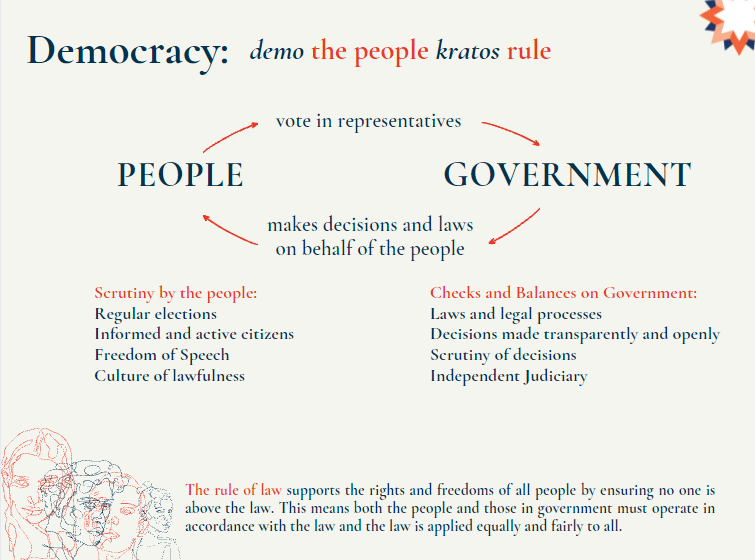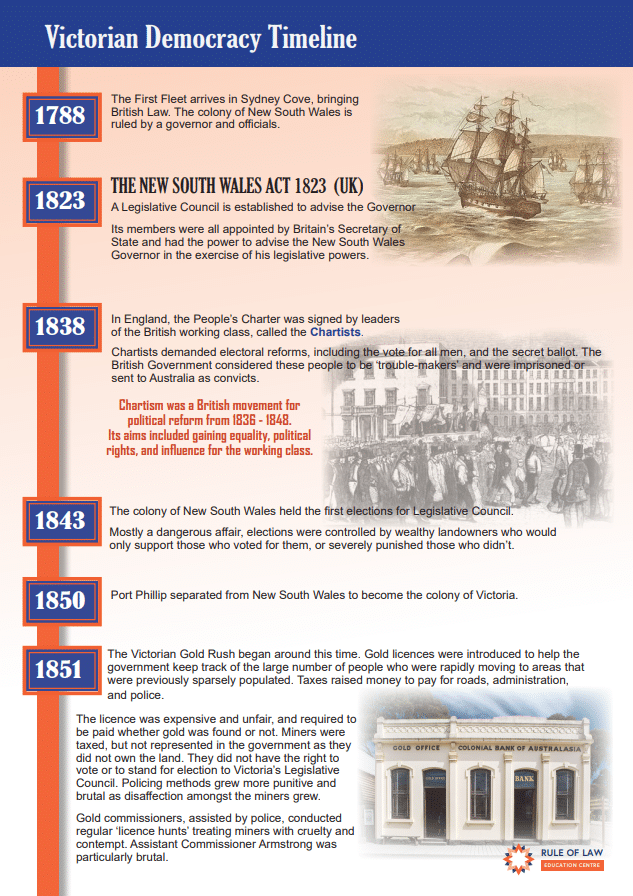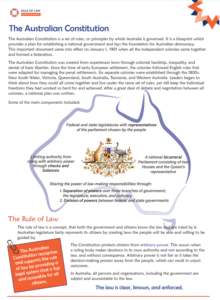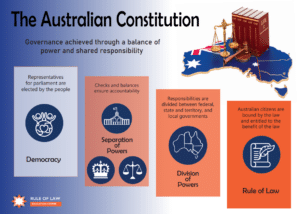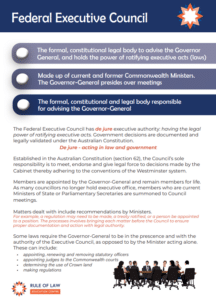Democracy in Australia
Australia’s System of Governance – Democracy is more than just voting
Australia follows the Westminster system, a democratic parliamentary system of government modelled on the politics of the United Kingdom and the United States of America. Australia’s democratic beliefs did not appear by chance but were developed over more than 200 years on Australian soil, over 800 years from England stemming back to the Magna Carta and over 1,500 years where the concept of democracy originated in Ancient Greece.
The book Australia’s Democracy by John Hirst starts by asking:
“How important is the right to vote? How does it compare with the advantages of living under a government that can’t lock you up without allowing you a fair trial, that can’t stop the criticisms of the media, that can’t control the judges, that itself has to obey the law? These things are an important part of what we understand by democracy.”
As outlined in our poster, democracy is more than just people having the vote. It also includes scrutiny by the people in the form of regular, free and fair elections, informed citizens, freedom of speech, freedom of association and freedom of the media, all within a culture of lawfulness. Furthermore, democracy requires there to be checks and balances on government including a constitution, laws and legal processes, open and transparent decision making, scrutiny of decisions, pluralistic system of government and an independent judiciary.
Many key elements of democracy were adopted at different times by different colonies. In the book, Australia’s Democracy the below table outlines the different Democratic Landmarks in the separate colonies and in the new Federation:
| NSW | VIC | SA | TAS | QLD | WA | Aust | UK | |
| Secret Ballot | 1858 | 1856 | 1856 | 1858 | 1859 | 1877 | 1901 | 1872 |
| Adult Male Sufferage (lower House) | 1858 | 1857 | 1856 | 1901 | 1872 | 1893 | 1902 | 1918 |
| No Property Qualification members lower house | 1858 | 1857 | 1856 | 1901 | 1872 | 1893 | 1901 | 1858 |
| Separation Church & State | 1862 | 1870 | 1851 | 1869 | 1860 | 1895 | 1901 | |
| Payment of Members | 1889 | 1870 | 1887 | 1890 | 1886 | 1900 | 1901 | 1911 |
| No Plural Voting | 1893 | 1899 | 1856 | 1901 | 1905 | 1907 | 1901 | 1948 |
| Female Suffrage | 1902 | 1909 | 1894 | 1903 | 1905 | 1899 | 1902 | 1928 |
| Adult suffrage upper house | 1978 | 1950 | 1973 | 1968 | 1964 | 1902 | ||
| Ombudsman | 1974 | 1973 | 1972 | 1978 | 1974 | 1971 | 1976 | 1967 |
| Freedom of information | 1989 | 1982 | 1991 | 1991 | 1992 | 1992 | 1982 | 2000 |
| Votes for Aborigines | *See note | 1985 | 1962 | 1962 | N/A |
* Note: Officially Aboriginal people had the same rights as others, but from 1902, because they were denied the right to vote in Commonwealth elections, they were often illegally denied the vote in state elections.
Events in Australia that led to its becoming a Democratic Nation under the Rule of Law
Establishment of the Colony- not a democracy but has elements of the rule of law
Click here to read about the Australian colonies and the development of the rule of law and the precursors to Democracy in Australia in the early colony including:
- The influence of British Law and the Magna Carta in the new colony of New South Wales
- The role of Lord Sydney and the First Charter of Justice in establishing a colony with the rule of law and a court system
- The first civil case in NSW and human rights
- The Rule of Law under the first 5 governors; and
- The Establishment of the Supreme Court
The Eureka Rebellion and its contribution to democracy in Australia
The Eureka Stockade had a significant impact on the development of democracy in the colonies and later within the Federation of Australia.
The Eureka Rebellion was a key moment where the people demanded equal and fair treatment and the right to take part in the democratic process. Click here to read more.
Not long after Eureka, a new system of administration in the Goldfields of Victoria was introduced that upheld Chartist principles such as:
- universal male suffrage
- secret ballot
- abolishment of property qualifications for voting and the system of one man, one vote; and
- payment of members.
Before Federation in 1901, the separate colonies of Australia such as NSW, Victoria etc (that we now know as States) had their own democracy outlined in their Constitution and formed their own parliaments.
Federation, the Australian Constitution and Democracy
After rigorous and extensive debate, an agreement was reached creating an overarching national constitution, written in 1900. As part of a British Act of Parliament, Federation took effect on 1 January 1901. The new Commonwealth of Australia Constitution Act (1901) has its foundation in principles that are derived from the Westminster system of governance, the United States Constitution, and principles from each colony’s constitution. Under this model, powers were distributed between a central government and various state governments to prevent one person, or group from dominating the nation.
Click here for more detailed information about the Australian Constitution.
What is in Australia’s Constitution and how is it democratic?
The Australian Constitution is a plan, a blueprint that outlines a set of rules on how Australia is governed. The Constitution is a key document for the development of democracy as it was conceived by Australians, drafted by Australians and approved by Australians. The British Parliament no longer has any power over Australia, and the Constitution’s power as a fundamental law of Australia relies on the Australian people’s decision to approve of and be bound by the terms of the Constitution.
- It establishes a federal government that must follow these processes: a national bicameral parliament – consisting of two Legislative Houses and the Queen’s representative;
- federal legislatures consist of representatives of the parliament that are directly chosen by the people;
- in choosing members of parliament, each elector is only given one vote
- authority is limited from overreach and arbitrary rule through checks and balances such as
1. the Separation of powers over three branches of government; the legislature, executive, and judiciary
2. the Division of powers between federal and state governments.
Each of the powers must operate in accordance with the Constitution. By separating and putting limits on power, it ensures each body works within their area of responsibility as defined within the Constitution.
This provides checks and balances to avoid power being held by one single body AND is instead distributed across the three bodies ultimately ensuring that it is the people who rule (ie democracy!!).
The Constitution protects all Australian citizens.
It recognises and supports the rule of law by providing a legal system that is fair and accessible to everyone
As outlined by John Hirst:
The delegates [drafting the Constitution] borrowed heavily from the federal constitution of the United States. They used the same names for the two houses of parliament, the House of Representative and the Senate, and they were coposed in the same way. In the Senate the states were to have an equal number of members. In the Representatives the people were to be represented, with the states having members according to their population. As in the United Staes, a court- the High Court- was to interpret the constitution. It would settle arguments between the Commonwealth and the states over their powers.
However, the Australians did not want to follow the Americans and elect a president. They wanted the government of the Commonwealth to be formed in the parliament and to be responsible to it. They wanted the Westminster system that they were used to in the colonies …
The constitution was to be altered by referendum- a very democratic method- but there had to be two majorities if a proposal were to be carried: a majority of people and a majority of the states “
Why are the separation of powers important in a democracy?
The Australian Constitution divides power between three branches of government referred to as the separation of powers. Chapters I to III of the Constitution outlines the legislative, executive and judicial powers of the Commonwealth as the three separate branches of government. Click here to learn more.
The Constitution includes checks and balances for the exercise of government power to ensure the powers of one branch are not in conflict with those of the other branches. The doctrine of separation of powers ensures that power isn’t vested in a single set of hands, but is disbursed across three branches of government.
An independent judiciary “assures people that court decisions will be based on the nation’s laws and constitution, not on shifting political power or the pressures of a temporary majority. Endowed with this independence, the judicial system in a democracy serves as a safeguard of the people’s rights and freedoms.” (www.principlesofdemocracy.org/judiciary)
Why is Bicameralism important in a democracy?
Bicameralism means having two parliamentary chambers to avoid a concentration of power in a single body.
This system divides power between two legislative chambers, providing a safeguard against the abuse of power from one group over another. It also ensures Parliament can hold the government to account by checking or restraining the use of government power. A single chamber (unicameral) does not provide equal representation as the majority of its members may be representatives of the government party who will vote as the government dictates. Unlike the two chambers in a bicameral parliament, which are more effective in keeping a check on government conduct.
A bicameral system also draws on different voting systems thereby increasing representatives in the Parliament. In New South Wales, for example, the members of the lower House represent individual constituencies and are elected according to optional preferential voting, while upper House members represent the entire State according to a system of proportional representation. This means that Parliament represents a wide range of different interests and views, making parliamentary processes more democratic in representing the people it serves.
Downloads
The Five Main Forms of Governance
The Five Main Forms of Governance POSTER
Different Forms of Government
Types of Government Venn Diagram
Timeline to Democracy
Magna Carta and the Rule of Law in Australia
Democracy in Australia
The Greatest Constitutional Document of All Time
The Australian Constitution
Separation of Powers
The 3 Branches of Power A3 POSTER
Separation of Powers CROSSWORD
Division of Powers
Australian Levels of Government
Passing a Bill
The National Cabinet
Federal Executive Council POSTER
Cabinet POSTER
National Cabinet POSTER
Australia becoming a nation – Change in Australian Society
Australia becoming a nation – Federation
Australia becoming a nation – Immigration
Australia becoming a nation – Suffrage
Australia becoming a nation – System of Government
Timeline Towards Federation
Study Task: Australia Becomes a Nation
Establishing Australia’s First Legal System
Study Task: Origins of Governance

